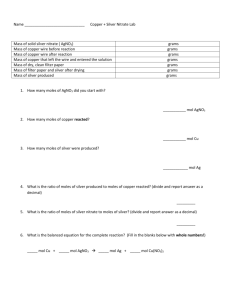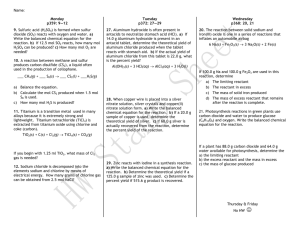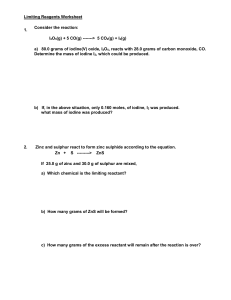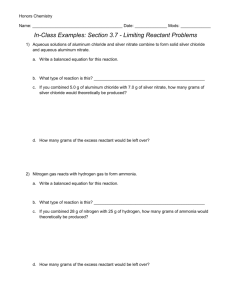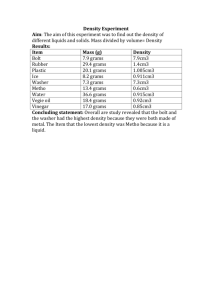HW Packet / Unit 5 The Chemical Equation as a Recipe HW #5.1
advertisement
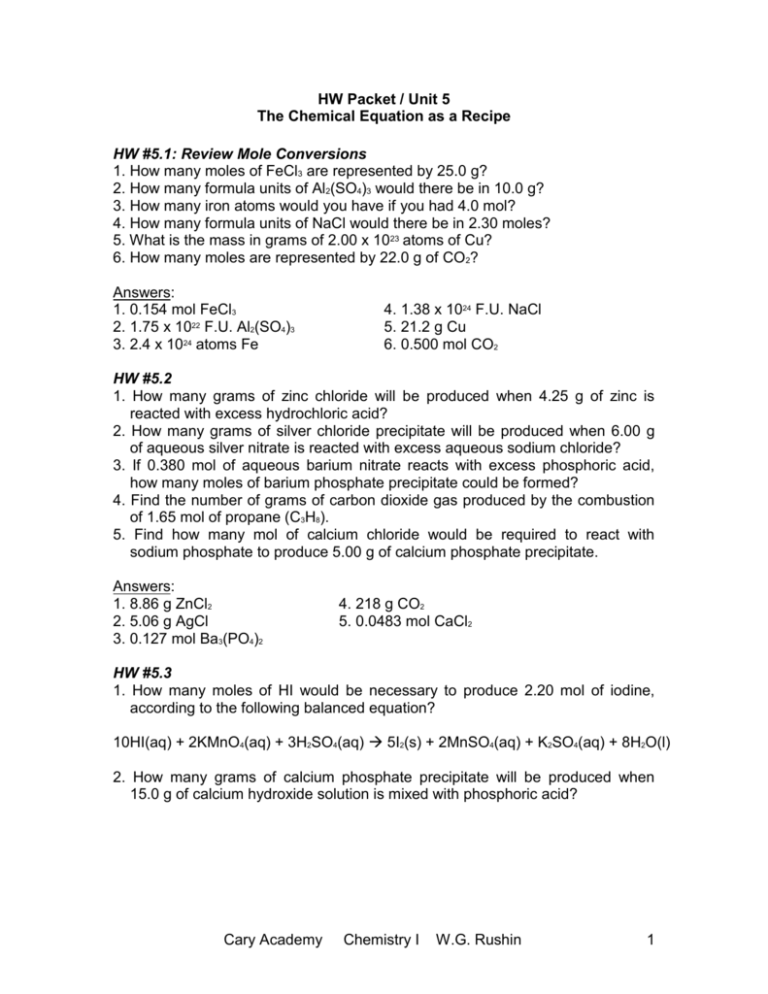
HW Packet / Unit 5 The Chemical Equation as a Recipe HW #5.1: Review Mole Conversions 1. How many moles of FeCl3 are represented by 25.0 g? 2. How many formula units of Al2(SO4)3 would there be in 10.0 g? 3. How many iron atoms would you have if you had 4.0 mol? 4. How many formula units of NaCl would there be in 2.30 moles? 5. What is the mass in grams of 2.00 x 1023 atoms of Cu? 6. How many moles are represented by 22.0 g of CO2? Answers: 1. 0.154 mol FeCl3 2. 1.75 x 1022 F.U. Al2(SO4)3 3. 2.4 x 1024 atoms Fe 4. 1.38 x 1024 F.U. NaCl 5. 21.2 g Cu 6. 0.500 mol CO2 HW #5.2 1. How many grams of zinc chloride will be produced when 4.25 g of zinc is reacted with excess hydrochloric acid? 2. How many grams of silver chloride precipitate will be produced when 6.00 g of aqueous silver nitrate is reacted with excess aqueous sodium chloride? 3. If 0.380 mol of aqueous barium nitrate reacts with excess phosphoric acid, how many moles of barium phosphate precipitate could be formed? 4. Find the number of grams of carbon dioxide gas produced by the combustion of 1.65 mol of propane (C3H8). 5. Find how many mol of calcium chloride would be required to react with sodium phosphate to produce 5.00 g of calcium phosphate precipitate. Answers: 1. 8.86 g ZnCl2 2. 5.06 g AgCl 3. 0.127 mol Ba3(PO4)2 4. 218 g CO2 5. 0.0483 mol CaCl2 HW #5.3 1. How many moles of HI would be necessary to produce 2.20 mol of iodine, according to the following balanced equation? 10HI(aq) + 2KMnO4(aq) + 3H2SO4(aq) 5I2(s) + 2MnSO4(aq) + K2SO4(aq) + 8H2O(l) 2. How many grams of calcium phosphate precipitate will be produced when 15.0 g of calcium hydroxide solution is mixed with phosphoric acid? Cary Academy Chemistry I W.G. Rushin 1 3. One of the most important chemical reactions that takes place on Earth is photosynthesis. All life forms depend on a fuel source (food) to provide energy for their various life processes. How many grams of water would a plant require to produce 1.00 mole of glucose according to the following equation: CO2(g) + H2O(l) + light C6H12O6(s) + O2(g) unbalanced 4. Glucose (C6H12O6) is used as a source of energy by the human body. The energy is produced from a combustion reaction involving glucose. How many grams of oxygen would be needed to react with 12.5 g of glucose to produce carbon dioxide and water. 5. The following equation describes the rusting of an old car: O2(g) Fe(s) + Fe2O3(s) unbalanced How much rust will result when 22.3 g of iron is oxidized? 6. Ammonia is synthesized from hydrogen and nitrogen according to the following equation: N2(g) + H2(g) NH3(g) unbalanced How many molecules of ammonia can be produced from 1.75 mol of hydrogen? 7. The compound "cisplatin", PtCl2(NH3)2, has been found to be effective in treating some types of cancer. It can be synthesized using the following reaction: K2PtCl4(aq) + NH3(aq) KCl(aq) + PtCl2(NH3)2(aq) unbalanced How much "cisplatin" can a drug company produce from 50.0 g of K2PtCl4? Answers: 1. 4.40 mol HI 2. 20.9 g Ca3(PO4)2 3. 108 g H2O 4. 13.3 g O2 5. 31.9 g Fe2O3 6. 7.00 x 1023 NH3 molecules 7. 36.1 g cisplatin HW #5.4 1. A 7.80 g piece of sodium metal reacts with 9.65 g of chlorine gas to produce sodium chloride. a. Which reactant is limiting? Which is in excess? b. How much salt can be produced (theoretical yield)? c. How much of the excess reactant will be left over? Cary Academy Chemistry I W.G. Rushin 2 2. A solution containing 2.45 g of potassium bromide is mixed with a solution containing 5.86 g of silver nitrate and a precipitate is produced? a. What is the maximum amount (theoretical yield) of silver bromide precipitate which can be formed from the reaction? b. How many grams of the excess reactant will be left over when the reaction stops? c. What would be left in the solution if the precipitate were filtered out? 3. A 1.40 g sample of magnesium metal is placed in a solution containing 8.30 g of sulfuric acid. a. How many grams of hydrogen gas can be produced (theoretical yield)? b. If 0.0824 g of hydrogen is actually obtained in the experiment, what is the percent yield? c. Calculate the grams of excess reactant remaining unreacted at the end of the reaction. 4. How many grams of water can be produced from the combustion of 1.50 mol of natural gas (methane: CH4) in the presence of 3.10 mol of oxygen? How many grams of the excess reactant will be left over? 5. A 3.67 g piece of aluminum is reacted with 9.11 g of hydrochloric acid. a. How many molecules of hydrogen gas will be produced? b. How many grams of excess reactant will left over? c. If the hydrogen molecules are collected in a balloon and then exploded, how many grams of water will be made? Answers: 1. b. 15.9 g NaCl c. 1.5 g 2. 3.87 g AgBr 3. a. 0.115 g H2 b. 71.7% yield c. 2.65 g 4. a. 54.0 g H2O b. 3.2 g 5. a. 7.50 x 1022 molecules H2 b. 1.4 g c. 2.25 g H2O HW #5.5 1. An experiment is performed in which 5.15 g of silver metal is reacted with 1.15 g of solid sulfur to produce silver sulfide. a. Write a balanced equation for the reaction. b. Identify the limiting and excess reactant. c. What is the maximum amount (theoretical yield in grams) of silver sulfide which can be produced from the reaction? d. How many grams of excess reactant will remain unreacted? e. If 5.00 g of silver sulfide is recovered, what is the percent yield for the experiment? Cary Academy Chemistry I W.G. Rushin 3 2. In an experiment, 52.4 g of zinc bromide is dissolved in water. This solution is mixed with a solution containing excess silver nitrate. A white precipitate is observed. The precipitate is recovered, dried, and found to have a mass of 60.1 g. a. Write a balanced equation for this chemical reaction. b. Identify the precipitate in this experiment by name and chemical formula. c. What is the theoretical mole ratio of the precipitate to zinc bromide. d. Calculate the experimental mole ratio of the precipitate to zinc bromide. e. What would be the percent error for this experiment as reflected by the mole ratio? f. What exactly would be left in the solution? 3. If 30.9 g of magnesium metal is reacted with 3.50 x 10 23 molecules of nitrogen gas, how much magnesium nitride can be produced (in grams)? How many grams of the excess reactant will be left over? 4. A 5.68 g piece of aluminum is placed in a solution containing 103.70 g of dissolved silver sulfate. a. How many grams of silver metal will be produced (theoretical yield) before the reaction runs out? b. How many grams of excess reactant will be left over? Answers: 1a. 2Ag(s) + S(s) Ag2S(s) b. LR - Ag, ER - S c. 5.91 g Ag2S d. 0.382 g S e. 84.6% yield 2a. ZnBr2(aq) + 2AgNO3(aq) 2AgBr(s) + Zn(NO3)2(aq) b. Silver bromide, AgBr(s) c. 2 d. 1.37 e. 31.5% error 3. 42.7 g Mg3N2, 4.48 g 4. a. 68.0 g Ag b. 5.3 g Cary Academy Chemistry I W.G. Rushin 4
